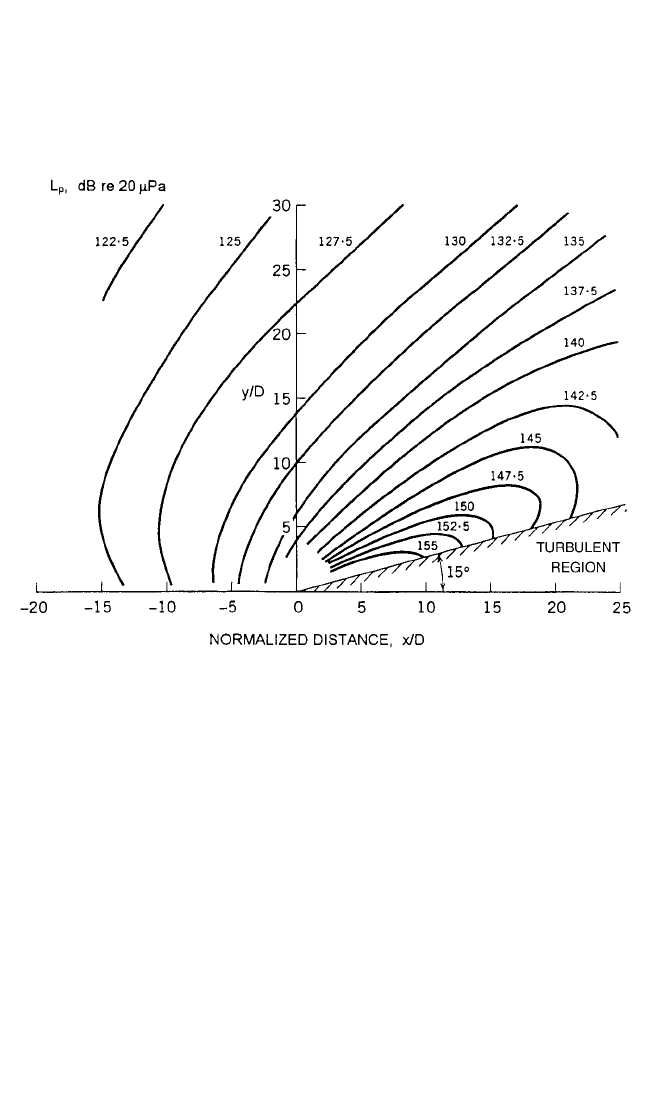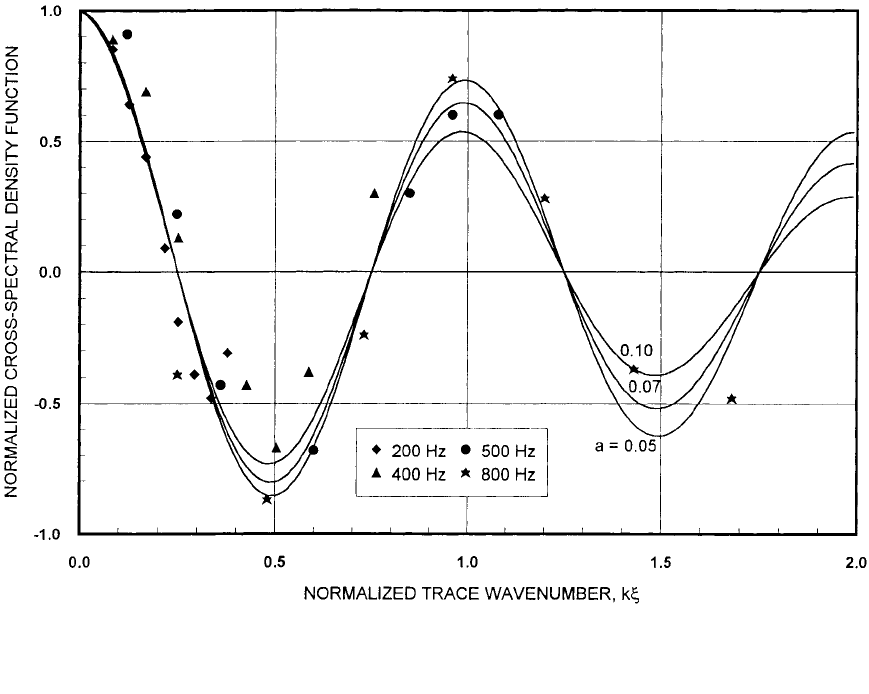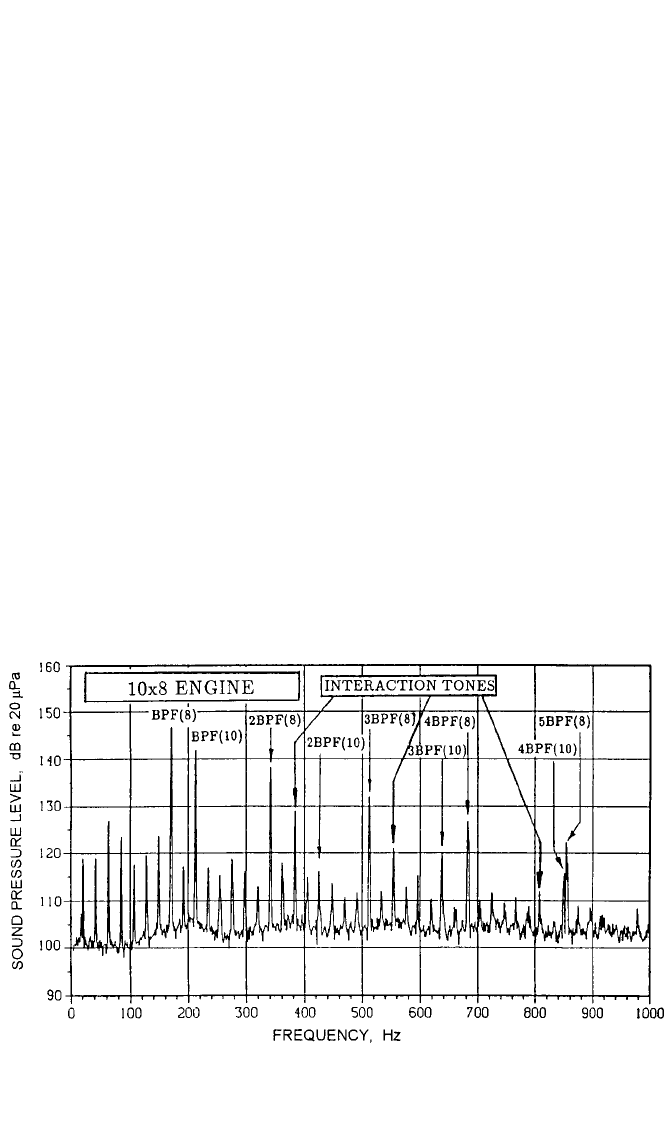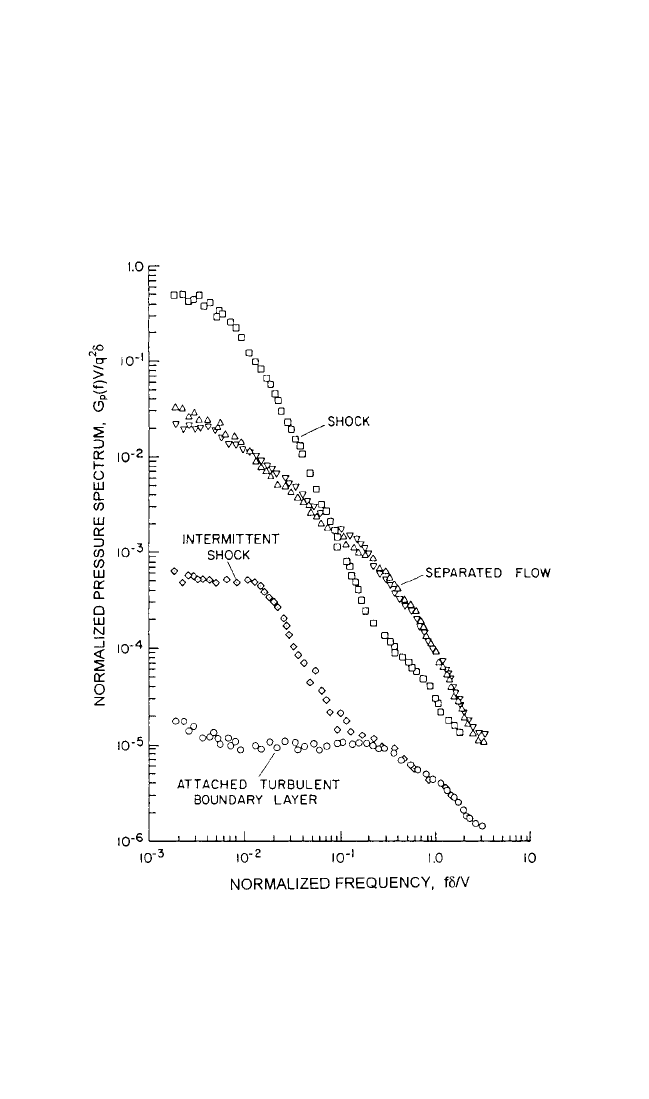Harris C.M., Piersol A.G. Harris Shock and vibration handbook
Подождите немного. Документ загружается.


50. Davenport, A. G., and G. N. Steels: J. Struct. Div. Am. Soc. Civil Engrs., 91:43 (April 1965).
51. Davenport, A. G.: Engineering Institute of Canada, 3:119 (1959).
52. McCaffrey, R. J., and Hartmann, A. J.: J. Struct. Div. Am. Soc. Civil Engrs., 98:1309 (June
1972).
53. Hashish, M. G., and Abu-Sitta, S. H., J. Struct. Div. Am. Soc. Civil Engrs., 100:1037 (May
1974).
29.46 CHAPTER TWENTY-NINE, PART II
8434_Harris_29_b.qxd 09/20/2001 11:44 AM Page 29.46

CHAPTER 29, PART III
VIBRATION OF
STRUCTURES INDUCED
BY SOUND
John F. Wilby
INTRODUCTION
Vibration of structures due to interaction with a surrounding fluid can occur in a
variety of ways. Parts I and II of this chapter are concerned with several fluid flow
phenomena—waves, vortices, and wind—that induce vibration in an adjacent struc-
ture. The intent in Part III is to address the response of structures to acoustic and
aeroacoustic excitations, where the term aeroacoustic includes sources, such as tur-
bulent boundary layers, that have many characteristics similar to those of an acoustic
field. The excitations can be deterministic or random in nature, as defined in Chap.
1, depending on the particular source.
Sound-induced vibration can result in sound radiation to other regions, acoustic
fatigue (also known as sonic or high-cycle fatigue) of the structure being excited, or
transmission of vibration to attached equipment causing malfunction or failure.
Interest is often centered on aerospace applications where structures are light-
weight and sound levels are high. In that case, there is the likelihood of damage to
the primary structure of an aerospace vehicle, payloads in a launch vehicle, or the
equipment mounted on the structure. However, structural vibration due to acoustic
excitation occurs in a wide range of other environments including building damage
and vibration of equipment in microelectronics manufacturing facilities.
Different acoustic and aeroacoustic sources will be described, followed by a dis-
cussion of methods for predicting linear and nonlinear response of structures to an
acoustic or aeroacoustic excitation. Then, the problem of acoustic fatigue will be
addressed. Finally, test methods for the measurement of structural response to
acoustic and aeroacoustic excitations will be identified.
SOUND SOURCES
Acoustic and aeroacoustic pressure fields may be deterministic or random, sta-
tionary or nonstationary, and homogeneous or inhomogeneous (see definitions in
29.47
8434_Harris_29_b.qxd 09/20/2001 11:44 AM Page 29.47

Chap. 1). Deterministic pressures are periodic or almost-periodic (see Chap. 22)
and can be described by time-dependent functions, whereas random pressures can
be described only in statistical terms (see Chap. 22). Stationary pressure fields have
properties that, on the average, are invariant with time. That is not true of nonsta-
tionary pressure fields, which can include impulsive excitations such as blast waves
and sonic booms. Homogeneous pressure fields have properties that, on the aver-
age, are the same at any location on a structure, whereas inhomogeneous pressure
fields have properties that change with location.The term aeroacoustic is used here
in a general sense to include sound produced by fluid flow or by interaction of
flows with solid bodies, and fluctuating aerodynamic pressures such as those
beneath a turbulent boundary layer. For convenience, and without loss of general-
ity, both acoustic and aeroacoustic pressure fields will be referred to herein as
sound fields.
One important characteristic of a sound field is that the fluctuating pressures are
distributed over a large area, if not the entire surface, of the excited structure, and
usually consist of a wide range of frequencies that includes several modes of vibra-
tion of the structure. The response of the excited structure depends on several prop-
erties of the sound field—sound pressure, frequency content, spatial distribution of
pressure level and phase, and duration of exposure. The spatial characteristics of a
random pressure field are best described in terms of the pressure cross-spectrum
(see Chap. 22), although narrowband correlation functions have been used as equiv-
alent representations (see Chap. 11). Sound pressures encountered in everyday life
cover a range of many orders of magnitude. Thus, it is convenient to express them in
terms of a logarithmic quantity called the sound pressure level, L
p
, which is
expressed in terms of decibels (dB) and is defined by
L
p
= 10 log
= 20 log
dB (29.57)
where p
rms
is the root-mean-square (rms) value of the sound pressure and p
ref
is a ref-
erence pressure that has been established by international standard to be p
ref
= 20
µPa in air.The common reference for underwater sound pressures is p
ref
= 1 µPa.
The range of sound pressure levels encountered in practice is demonstrated by
the typical values listed in Table 29.4. The levels vary from 0 dB at the threshold of
human hearing to 170 dB or more on some surfaces of aerospace vehicles, well
above the threshold of pain for a human. Typical sound pressure levels near a busy
highway are on the order of 80 dB, and noisy machinery can generate sound pressure
levels of about 100 dB at the operator’s position.
Structural response to sound is of interest in a variety of situations but, as indi-
cated by Table 29.4, the most intense sound fields can be found in aerospace appli-
cations. Thus, aerospace vehicle sound sources are of special interest and provide a
wide range of characteristics. The sources include the exhaust of jet and rocket
engines, propellers and fans, powered lift devices, turbulent boundary layers, oscil-
lating shock waves, and sonic booms.
1
In many cases, the pressure field is neither sta-
tionary nor homogeneous. However, it is often acceptable to assume stationarity and
homogeneity when predicting the response of a structure, if the variations in space
and time are gradual. There are exceptions to this assumption, for example, pro-
peller noise where the pressure field is strongly inhomogeneous with the sound
pressure levels being very high in the plane of rotation of the propeller and decreas-
ing rapidly in the forward and aft directions.A survey of near-field pressure fields on
flight vehicles can be found in Ref. 2.
p
rms
p
ref
p
2
rms
p
2
ref
29.48 CHAPTER TWENTY-NINE, PART III
8434_Harris_29_b.qxd 09/20/2001 11:44 AM Page 29.48

Although the following discussion on sound sources is directed toward aerospace
vehicles, it should be viewed more generally in terms of sound-generating mecha-
nisms that can be found in a wide range of situations. For example, the high-velocity
gas exhaust from a pressure relief valve has acoustical characteristics similar to
those of a jet engine exhaust. Axial fans in air-conditioning systems or gas-cooled
nuclear reactors have similar noise-generating mechanisms to those of a turbofan
engine. Also, regions of flow separation on an automobile can have characteristics
that are similar to those for separated flow on an airplane.
JET AND ROCKET EXHAUSTS
Jet and rocket noise is generated by interaction between the turbulent exhaust of the
jet or rocket engine and the surrounding air. At low exhaust velocities, below about
1000 ft/sec (300 m/sec), the acoustic power generated by the exhaust is proportional
to the eighth power of the exhaust velocity, V
j
. However, as the velocity increases the
index decreases until, for rocket exhausts, where the exhaust velocity is of the order
of 9000 ft/sec (2750 m/sec), the acoustical power is proportional to the third power
of velocity. As the mechanical power of a rocket exhaust is also proportional to V
j
3
,
the acoustical power of a rocket exhaust is usually expressed in terms of an effi-
ciency factor η, which is the ratio of acoustical power W
a
to mechanical power W
m
.
That is,
W
a
=ηW
m
= 0.5ηTV
j
(29.58)
where T is the thrust of the rocket engine.Typical values
3,4
of the efficiency factor are
usually in the range 0.5 to 1.0 percent.
Since jet noise levels are determined by the relative velocity between the exhaust
and the surrounding air, the noise levels will decrease as the vehicle accelerates at
takeoff or liftoff, the highest levels occurring when the vehicle is stationary.This vari-
ation of noise level with vehicle speed means that the noise levels are nonstationary,
although they can be considered as stationary over short time periods.
VIBRATION OF STRUCTURES INDUCED BY SOUND 29.49
TABLE 29.4 Typical Sound Pressure Levels for Different Environments
Sound pressure
level L
p
(dB re 20 µPa) Environment
170 Jet noise on aircraft surface
160 Immediate hearing damage
140 Threshold of pain
120 Jet airplane takeoff at 1500 ft (500 m)
100 Punch press and wood planers at 3 ft (1 m)
90 Power mower at 3 ft (1 m)
80 Truck at 60 ft (20 m)
70 Automobile at 60 ft (20 m)
50 Conversation level, A-weighted, in a free field, at 3 ft (1 m)
40 Quiet residential neighborhood
20 Recording studio,A-weighted
0 Threshold of hearing
8434_Harris_29_b.qxd 09/20/2001 11:44 AM Page 29.49

Jet noise is strongly directional, with the highest sound pressure levels in the far
field occurring at angles of 30 to 50° to the jet axis, the angle being dependent on the
exhaust velocity. The situation is not so well defined in the near field, where the air-
craft structure is located. Representative near-field pressure contours can be found
in Refs. 4 to 7, and typical contours are shown in Fig. 29.33.
7
29.50 CHAPTER TWENTY-NINE, PART III
FIGURE 29.33 Jet noise near-field sound pressure levels. D = nozzle diameter, x = distance
downstream of nozzle, y = distance from jet axis. (Reproduced with permission of ESDU Inter-
national.
7
)
Jet noise spectra are broadband and peak at different frequencies for different
locations in the near field.
5–7
The spectra can be normalized in terms of a nondimen-
sional frequency using jet nozzle diameter D and jet velocity V
j
as the normalizing
parameters. Then, the frequency of the spectral peak lies in the range 0.1 < fD/V <
1.0, depending on location relative to the nozzle, as shown in Fig. 29.34.
7
The spatial distribution of the pressure phase for a jet noise near field can be pre-
sented in terms of the band-limited (e.g., one-third-octave band) crosscorrelation
function
5,8,9
(see Chap. 11) or the normalized cross–spectral density function γ
p
(ξ,f)
(see Chap. 22), since the two functions are equivalent. Typical measured values of
γ
p
(ξ,f) for jet noise pressures close to a jet
8,9
are shown in Fig. 29.35. Frequency f is
normalized with respect to separation distance ξ and the trace wavespeed of the inci-
dent sound, in order to permit scaling from one situation to another. Trace
wavespeed V
t
is the wave speed of the incident sound when projected onto the sur-
face of the excited structure. Thus, for sound waves of speed c incident at an angle θ
to the normal to the surface, the trace wavespeed is c/sin θ. The value of V
t
is often
frequency dependent and, in the case of the data in Fig. 29.35, has values of 1.43c,
1.25c, and 1.0c for frequencies 400, 500, and 800 Hz, respectively. These values of the
8434_Harris_29_b.qxd 09/20/2001 11:44 AM Page 29.50

trace wavespeed correspond to angles of incidence of 44, 53, and 90°, respectively.
The different angles of incidence are associated with the different locations in the jet
exhaust of the effective noise sources for different frequencies. Figure 29.35 refers to
measurements made in a plane passing through the jet axis. Corresponding infor-
mation in a direction perpendicular to that plane are less well defined.
For convenient substitution into analytical models, the normalized cross-spectrum
is often represented as an exponentially decaying cosine, with the general form
γ
p
(ξ,f) = e
−
ak|ξ|
cos (kξ) (29.59)
where a is a decay parameter and k is the wave number of the pressure field, where
wave number is defined by
k == (29.60)
Curves of γ
p
(ξ,f) are shown in Fig. 29.35 for three values of the decay parameter a,
namely, 0.05, 0.07, and 0.10.
Supersonic jet exhausts that are under- or overexpanded contain shockwaves
that result in the generation of additional broadband noise and discrete frequency
screech.
1
The screech consists of a fundamental component, whose frequency is a
function of nozzle pressure ratio or flow Mach number, and several harmonics. The
directivity of the screech noise is a function of harmonic order, with the fundamen-
tal having a maximum in the upstream direction and the second harmonic having a
multilobed directivity pattern with peaks in directions perpendicular to the flow
direction, as well as in the upstream direction.
2πf
V
t
ω
V
t
VIBRATION OF STRUCTURES INDUCED BY SOUND 29.51
FIGURE 29.34 Normalized sound pressure spectra for several locations in jet noise near-
field. V = jet velocity; D, x, y, as defined in Fig. 29.33. (Reproduced with permission of ESDU
International.
7
)
8434_Harris_29_b.qxd 09/20/2001 11:44 AM Page 29.51

FIGURE 29.35 Example of normalized cross-spectral density function for jet noise near
-field pressures. Test
data collapsed with trace velocity V
t
= 1.43c (200, 400 Hz), 1.25c (500 Hz), and 1.0c (800 Hz). Continuous plots
represent Eq. (29.59) with decay parameter a = 0.05, 0.07, and 0.10. (Data from Richards and Mead.
9
)
29.52
8434_Harris_29_b.qxd 09/20/2001 11:44 AM Page 29.52

ENGINE EXHAUST FLOWS
Powered lift aircraft utilize the exhaust from the engines to augment the lift gener-
ated by the wing and increase the effectiveness of the control surfaces, utilizing sys-
tems such as upper surface blowing and externally blown flaps.
1
By so doing, the
surfaces of the aircraft are exposed to high sound pressure levels that are a combi-
nation of acoustic and aeroacoustic pressures. For example, sound pressure levels of
up to 165 dB were measured on an airplane with upper surface blowing.
10
In addi-
tion, the structure was heated to a temperature of 500 to 700°F (260 to 370°C). A
similar situation exists on stealth aircraft where the engine exhaust flows over the
upper surface of the aft structure so that the gases are cooled before they can be
observed from below.
10
Sound pressure levels greater than 180 dB are predicted in
the neighborhood of the exhaust flows on hypersonic aircraft.
10–12
PROPELLERS AND FANS
Propeller or fan noise consists of both broadband and discrete frequency compo-
nents, but the pressure spectrum is dominated by discrete frequency components at
the blade passage frequency of the propeller or fan and harmonics thereof. The
blade passage frequency f
b
is given by
f
b
= (29.61)
where Ω is the rotational speed (rpm) of the propeller or fan and B is the number of
blades. The spectra for counter-rotating propellers are more complex, with blade
passage frequency components for each of the propellers plus interaction tones,
13
as
shown in Fig. 29.36. The spectrum in the figure also contains components for each
individual blade of the propeller, because the blades are not identical.
ΩB
60
VIBRATION OF STRUCTURES INDUCED BY SOUND 29.53
FIGURE 29.36 Spectrum for near-field sound pressure levels of high-speed, counter-rotating pro-
peller with 8 and 10 blades. BPF(8) and BPF(10) denote blade passage frequencies for 8- and 10-blade
propeller stages, respectively. (Simpson, Druez, Kimbrough, Brock, Burge, Mathur, Cannon, and Tran.
13
)
8434_Harris_29_b.qxd 09/20/2001 11:44 AM Page 29.53

Sound pressure levels on the fuselage of multiengined general aviation aircraft
are typically of the order of 130 dB at the blade passage frequency. High-speed pro-
pellers, with tip speeds that are supersonic under cruise conditions, have higher
sound pressure levels on the order of 150 dB.
13
Cross-spectrum measurements of propeller noise on a general aviation airplane
14
show that the pressure field in the plane of rotation is an aerodynamic potential field
that rotates with the propeller blades. Forward and aft of the plane of rotation the
pressure field is acoustic and has the characteristics of propagating acoustic waves gen-
erated by sources located near the tips of the propeller blades. The spatial distribution
of the cross-spectrum phase is more complicated for counter-rotating propellers.
15
TURBULENT BOUNDARY LAYER
The dominant fluctuating pressures acting on launch vehicles, missiles, and aircraft
in high-speed flight are associated with the turbulent boundary layer on the external
surfaces of the vehicle. Similar fluctuating pressure fields are also encountered on
other moving vehicles including automobiles, particularly around the windshield,
and high-speed elevators. These pressure fields have many of the characteristics of
an acoustic pressure field, but the convection velocity of the pressure fluctuations
over the surface may be subsonic in contrast to an acoustic field where the trace
velocity is always equal to, or greater than, the speed of sound in the fluid. There are
also differences in the cross-spectra.
Measurements of turbulent boundary layer pressure fluctuations have been
made in wind tunnels, on aircraft in flight, and underwater.
9,16–18
The measurements
have included both subsonic and supersonic flow conditions, but the emphasis has
been on subsonic conditions.A combination of analytical and empirical methods has
resulted in representations for the various characteristics of turbulent boundary
layer pressure fields for both attached and separated flow.
For an attached turbulent boundary layer, taking into account compressibility
effects, the rms pressure p
rms
can be expressed as a function of Mach number, in rela-
tionships such as
19
= (29.62)
where q is the dynamic pressure of the flow, given by q =
1
⁄2ρV
2
where V is velocity, ρ
is the density of the fluid, and M is the flow Mach number, defined at some location
such as free stream or the edge of the boundary layer. Corresponding relationships
can be developed for separated flow conditions.
The pressure spectrum G
p
(ω) for an attached turbulent boundary layer is broad-
band and can be represented by a relationship of the form
19
= (29.63)
where κ is a function of flow Mach number, V is the flow velocity, and δ* is the
boundary layer displacement thickness. The boundary layer displacement thickness
is the distance that the surface beneath the boundary layer would have to move out-
ward and normal to itself to account for the differences in the rate of mass flow with
the boundary layer present and, hypothetically, without the boundary layer. Sepa-
rated turbulent boundary layers in the neighborhood of steps, ramps, and other sur-
2κ(p
rms
/q)
2
π
1 +
κω
V
δ*
2
G
p
(ω)V
q
2
δ*
0.006
1 + 0.13M
2
p
rms
q
29.54 CHAPTER TWENTY-NINE, PART III
8434_Harris_29_b.qxd 09/20/2001 11:44 AM Page 29.54

face discontinuities have higher pressure levels at low frequencies than is the case
for attached boundary layers, as shown in Fig. 29.37.
18
Pressure spectrum and fre-
quency are normalized in Fig. 29.37 with respect to boundary layer thickness δ rather
than boundary layer displacement thickness δ*. Boundary layer thickness can be
defined as the distance from the surface at which the flow velocity reaches 99.5 per-
cent of the free stream velocity. Equation (29.63) can be modified to take into
account the low-frequency shifts seen in Fig. 29.63 by replacing κ with Cκ, where
C > 1. The presence of oscillating shockwaves further increases the low-frequency
component of the pressure spectrum,
18
as can be seen in Fig. 29.37.
VIBRATION OF STRUCTURES INDUCED BY SOUND 29.55
FIGURE 29.37 Pressure spectra beneath different turbulent boundary
layers in supersonic flow. G
p
(f) = G
p
(ω)/2π, V = flow velocity, q = flow
dynamic pressure, δ=boundary layer thickness. (Coe, Chyu, and Dods.
18
)
Normalized cross-spectra or band-limited cross-correlation functions have been
measured for attached turbulent boundary layers.
16,17
The measured data indicate
that the normalized cross-spectrum is dependent on the thickness of the boundary
layer δ as well as on the convection speed V
c
of the pressure field and the separation
distance ξ between the measuring points. Empirical relationships such as
20
8434_Harris_29_b.qxd 09/20/2001 11:44 AM Page 29.55
